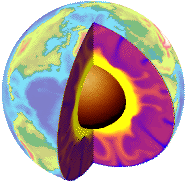Under The Crust
 Three centuries ago, the English scientist Isaac Newton calculated, from his studies of planets and the force of gravity, that the average density of the Earth is twice that of surface rocks and therefore that the Earth's interior must be composed of much denser material. Our knowledge of what's inside the Earth has improved immensely since Newton's time, but his estimate of the density remains essentially unchanged. Our current information comes from studies of the paths and characteristics of earthquake waves travelling through the Earth, as well as from laboratory experiments on surface minerals and rocks at high pressure and temperature. Other important data on the Earth's interior come from geological observation of surface rocks and studies of the Earth's motions in the Solar System, its gravity and magnetic fields, and the flow of heat from inside the Earth.
Three centuries ago, the English scientist Isaac Newton calculated, from his studies of planets and the force of gravity, that the average density of the Earth is twice that of surface rocks and therefore that the Earth's interior must be composed of much denser material. Our knowledge of what's inside the Earth has improved immensely since Newton's time, but his estimate of the density remains essentially unchanged. Our current information comes from studies of the paths and characteristics of earthquake waves travelling through the Earth, as well as from laboratory experiments on surface minerals and rocks at high pressure and temperature. Other important data on the Earth's interior come from geological observation of surface rocks and studies of the Earth's motions in the Solar System, its gravity and magnetic fields, and the flow of heat from inside the Earth.
The planet Earth is made up of three main shells: the very thin, brittle crust, the mantle, and the core; the mantle and core are each divided into two parts. Although the core and mantle are about equal in thickness, the core actually forms only 15 percent of the Earth's volume, whereas the mantle occupies 84 percent. The crust makes up the remaining 1 percent. Our knowledge of the layering and chemical composition of the Earth is steadily being improved by earth scientists doing laboratory experiments on rocks at high pressure and analyzing earthquake records on computers.
Because the crust is accessible to us, its geology has been extensively studied, and therefore much more information is known about its structure and composition than about the structure and composition of the mantle and core. Our knowledge of the upper mantle, including the tectonic plates, is derived from analyses of earthquake waves; heat flow, magnetic, and gravity studies; and laboratory experiments on rocks and minerals. Between 100 and 200 kilometers below the Earth's surface, the temperature of the rock is near the melting point; molten rock erupted by some volcanoes originates in this region of the mantle. The core was the first internal structural element to be identified. It was discovered in 1906 by R.D. Oldham, from his study of earthquake records, and it helped to explain Newton's calculation of the Earth's density.
Fact Credit
USGS General


